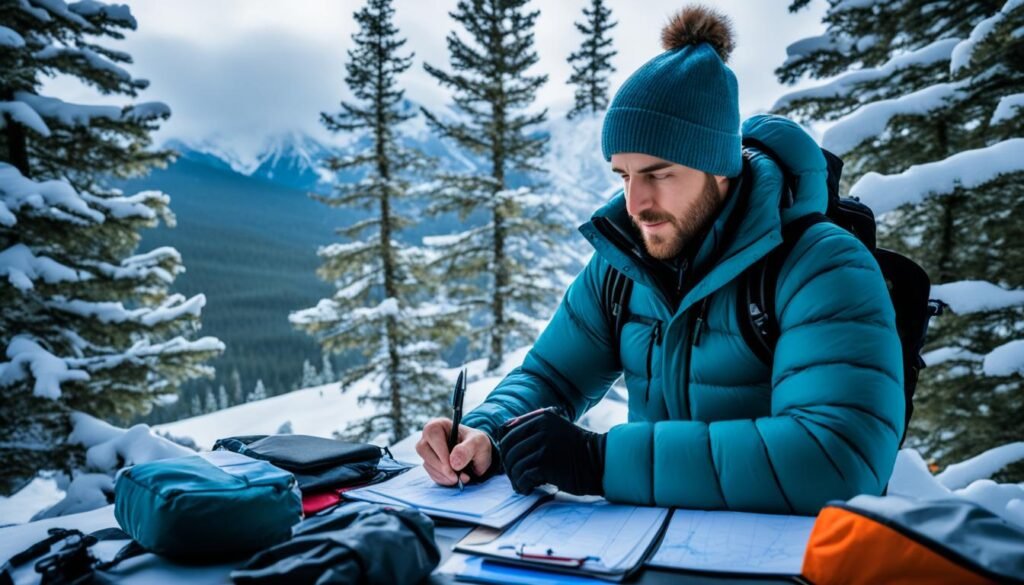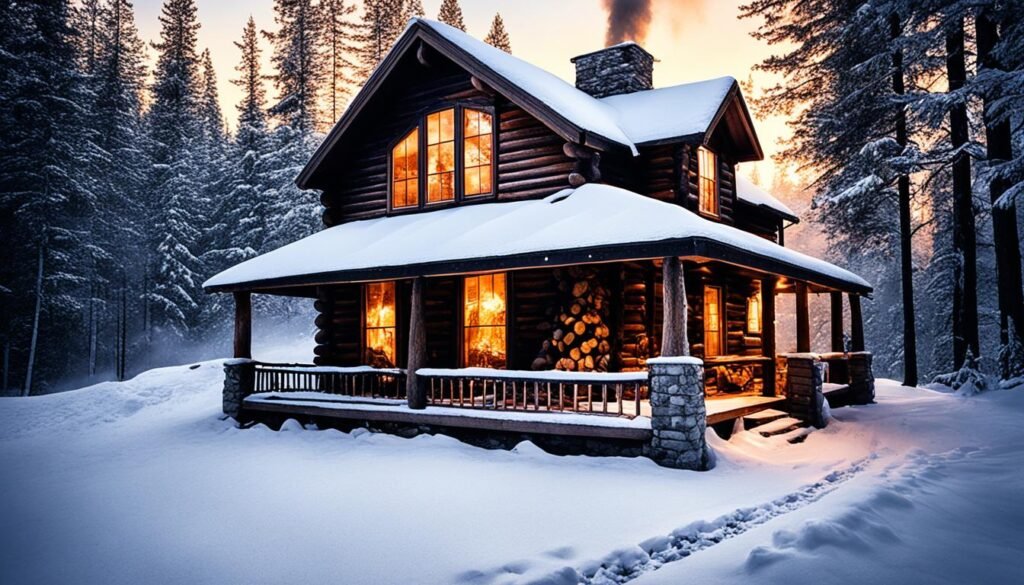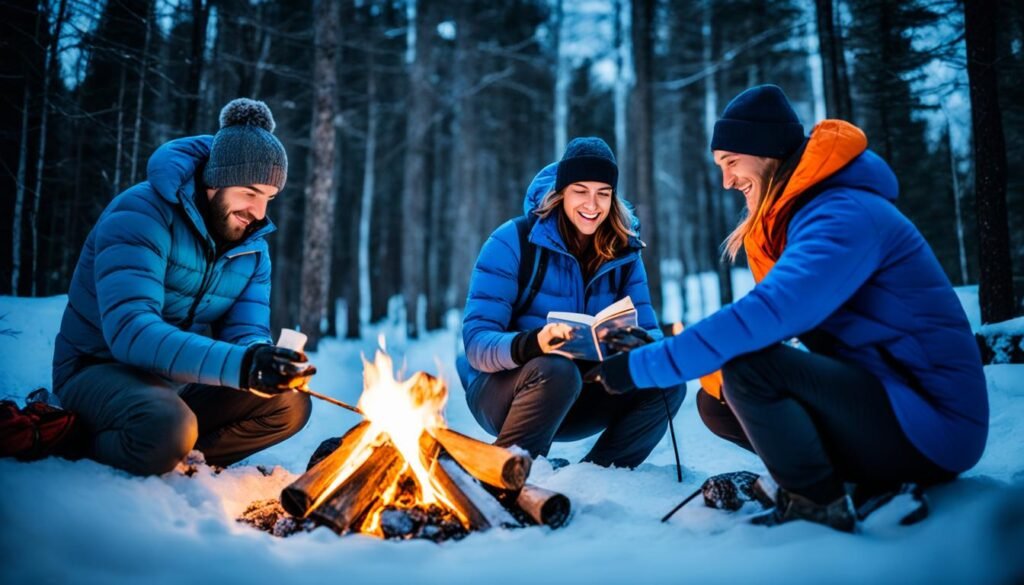Winter camping is unique. It offers peace with fewer people around. Enjoying nature’s quiet beauty alone is special. But, cold weather brings challenges. Being ready is key. New campers should start when it’s a bit warmer. Try spots close to home. Stick to a one-night trip at first. State parks in Wisconsin, like the one near Milwaukee, are good for car camping tests.
You can borrow or rent gear. This saves money. It also helps figure out what you like before spending a lot. A good winter camping list and tips are crucial. They change a tough trip to a fun one. You’ll need a warm sleeping bag, insulated pads, and a sturdy tent for the snow.
It’s key to know the dangers of winter camping. Frostbite and hypothermia are risks. Always eat well and stay hydrated to keep warm. Planning your route well is part of staying safe. It ensures a fun and safe adventure. Starting with a great first trip can make you feel proud. Later, like when camping in the Adirondacks, you may need more gear to stay warm in colder temps.
Why Winter Camping?
Winter camping has many benefits. It offers a calm and peaceful camping experience. Because fewer people camp in winter, you can enjoy solitude in nature. It feels different from the busy summer.
Winter camping builds key skills. It teaches you how to stay warm and use gear in the cold. Start with easier weather to learn and have fun. It’s all about blending challenge and joy.
Getting ready is important. Planning and packing right are key, especially for beginners. Try borrowing or renting gear before buying. This way, you find out what you like without spending a lot.
I learned to love winter camping step by step. Make sure you have the right gear, like a sturdy tent and a warm sleeping bag. Bring a headlamp and a first aid kit. For overnight trips, hot food matters. It makes the cold feel cozy.
Winter camping is unique. It brings peace and a chance to improve skills. The experience makes your bond with winter nature deep and fulfilling.
Picking the Perfect Winter Camping Destination
Choosing the perfect winter camping spot is exciting. It’s crucial to think about distance, beauty, and weather for safety and fun.
The Southwest of the US is great for those wanting warmer weather. It lets you visit beautiful places like Zion and Bryce Canyon. These parks in Southern Utah look amazing with snow on red rocks.

The Pacific Northwest, known for its greenery, offers stunning winter views. Places like Mount Rainier are open all year. But, remember to check if snow has closed any roads or trails.
The Northeast has places like New Hampshire’s White Mountains. They offer beautiful, snow-covered landscapes. This area is perfect for those looking for a challenge.
The US has many winter camping spots, from the Rockies to the Great Smoky Mountains. Using resources like REI’s winter camping advice can help you choose the best spot.
Good planning is key to a great winter camping trip. Whether it’s stunning national parks or quiet, secluded areas, planning ensures a safe and memorable experience.
Essential Gear for Winter Camping
Choosing the right gear for winter camping is crucial. It makes your experience comfy and safe in the cold. Cold-weather tents are a must for extreme conditions, unlike three-season tents.
I suggest the Feathered Friends Snowbunting EX 0 sleeping bag for $719. It’s top-rated for insulation. Pair it with the Therm-a-Rest NeoAir XTherm NXT sleeping pad at $240. You’ll stay warm all night. Also, bring a reliable stove like the MSR WindBurner for $190.
A good headlamp like the Petzl Actik Core for $80 is essential. Wear heavy jackets like the Rab Neutrino Pro for $400. Add a hardshell jacket, such as the Arc’teryx Beta AR, for $600.
Don’t forget about your legs. Arc’teryx Sabre Pants cost $600 and offer great protection. For base layers, try the Smartwool Classic Thermal Merino 1/4-Zip at $120. And the Arc’teryx Atom Jacket for $280 is a great midlayer.
Keep hands and feet warm too. Black Diamond Guide Gloves are $180. Smartwool Ski Full Cushion OTC socks for warm feet cost $29.
For backcountry trips, get quality snow gear. Blizzard Zero G 105 skis are $900. Pomoca Climb Pro S-Glide climbing skins cost $220, and Scarpa Maestrale RS boots are $949.
You’ll need a Black Diamond Mission 75 backpack for $255. MSR DynaLock Ascent Carbon poles are $190. Don’t skip on avalanche safety gear. Get a Backcountry Access Tracker3 beacon for $350 and a Black Diamond QuickDraw Pro 240 probe for $60. A Black Diamond Transfer shovel is $65, vital for emergencies.
Always carry the Ten Essentials when exploring winter landscapes. They include navigation, cold-weather gear, and emergency items. By choosing the right equipment, you make your winter camping safe and fun.
How to Plan a Winter Camping Trip
Planning a winter camping trip needs careful thought. It blends safety with fun. Whether you’re experienced or new, a good plan is crucial. Start by gaining experience in easier camping conditions. Taking classes or learning from experts helps a lot with cold-weather prep.
Upgrading gear and clothing is key for winter camping. You’ll need four-season tents because they’re strong against winter weather. Their sales go up in winter, showing their importance.

Begin with short trips to places you know. This helps you know your limits and if your gear works well. Make sure to check the weather and if you can get to your site.
Drinking lots of water and eating enough food is crucial in the cold. You need more calories and water to stay warm and hydrated. Your meals should be full of energy to help you stay warm.
Knowing your water sources is important. Many campers melt snow for water. But, you must plan to have enough fuel for melting snow.
People often camp longer in winter than summer. This shows they’re getting used to the cold. Planning well makes for a safe, great time in the snow.
Preparing for Your Winter Adventure
Going on a winter adventure takes more planning than regular camping. The first thing to do is check the weather and avalanches in your area. Knowing your skills and having the right gear is key. You need a tent that can handle snow, a warm sleeping bag, and clothes that keep you warm.
It helps to press down the snow where you’ll sleep because it keeps heat better. Getting to your camping spot can be hard if snow blocks the way. Learning how to find your way in the snow is crucial since trails are hard to see and moving can be slow.
Staying warm means eating right and drinking plenty of water, even if you’re not thirsty. Packing food that gives you lots of energy is important. Keeping your food safe from animals and making sure your melted snow is safe to drink are also key steps.
Pack clothes in layers to stay warm as you move or rest. Wool is great for winter because it traps warm air. Keeping dry is important to avoid hypothermia, so adjust your layers to avoid sweating too much.
Don’t ignore the risk of avalanches. Pick a safe place for your tent, away from trails and water to protect nature. Your tent must be strong against snow and wind for a safe camping trip.
Winter Camping Safety Tips
Winter camping safety starts with knowing the risks of cold weather. It’s key to know about hypothermia and frostbite. Being ready means eating well and staying hydrated. Meals should be hot and full of nutrients. You also need enough calories.
Watching weather reports and avalanche forecasts is crucial. This is very true in areas with avalanches, like the Pacific Northwest. Wear the right avalanche safety gear, including a transceiver, probe, and shovel. Know how to use them. You’ll also need warm sleeping bags, the right clothes, and a strong tent. Plus, keep a first aid kit close. Knowing how to build shelters or fires is also vital.
Set up your camp to be safe from wind and rain. What you wear is super important. Wool keeps you warm because it traps air. Make sure to adjust your clothing to stay dry. This helps avoid losing too much heat. Managing sweat is also key to your safety.
It’s important to balance staying warm but not too hot. The right layers matter a lot. Learn about the “clo” measurement for guidance. This way, you can enjoy winter camping. And you can stay safe from avoiding hypothermia and preventing frostbite.
Food and Hydration Tips for Winter Camping
Eating meals that give you high energy and nutrition is key in cold weather. You need foods that are rich in calories and a good way to cook them when camping in winter. This combo keeps you warm and energized during your adventure.
One-pot meals are great because they make cooking simple and give you big servings. Think about making pasta, chili, or stew on a small camp stove. Make sure your stove works well in cold weather. Some stoves are better for this because of how the fuel acts in the cold.
Drinking enough water when it’s cold is just as important. You might have to melt snow for water. But, watch out so your water bottles and hydration packs don’t freeze. Wrapping your bottles or keeping them close to your body helps to stop them from freezing. When it comes to drinking water, many campers prefer bottles to hydration reservoirs. They do this to keep the drinking tubes from freezing.
- Plan your winter camping meals to be high-energy and easy to cook.
- Use insulated containers to keep food warm longer.
- Prepare hot foods like oatmeal or soup that provide warmth and sustenance.
- Extra snacks like trail mix, cheese, and salami can offer quick energy boosts.
- Always pack extra food in case you stay longer than anticipated due to weather conditions.
To stay warm and healthy while camping in winter, drink a lot of water and eat many calories. Good planning for meals and water makes your trip safer and more fun.
Navigation and Route Planning for Winter Camping
Winter camping navigation and route planning are very important. They make your adventure safe and fun. I always start by looking closely at maps and info from the National Weather Service. This is because heavy snow can change or block trails. I check if trailheads are open in winter. I also make sure my paths stay clear of avalanche danger zones.
I always bring detailed topographical maps and a compass for navigation. Knowing the area and landmarks before I go keeps me on track in the snow. When planning, I think about moving slower because of less daylight and snow. Sometimes, I need special gear like snowshoes or skis to move through snow.
It’s also key to set up my tent right in the winter. I build snow walls and pack down snow for the tent. I dig a vestibule and use snow stakes for the wind and snow. To stay safe, I manage my body heat and look out for cold injuries. Following Leave No Trace (LNT) is important too. I camp on snow and avoid plants to protect nature and stay safe.







